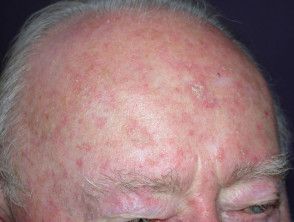- Acne
- Actinic Keratosis
- Aesthetics
- Alopecia
- Atopic Dermatitis
- Buy-and-Bill
- COVID-19
- Case-Based Roundtable
- Chronic Hand Eczema
- Chronic Spontaneous Urticaria
- Drug Watch
- Eczema
- General Dermatology
- Hidradenitis Suppurativa
- Melasma
- NP and PA
- Pediatric Dermatology
- Pigmentary Disorders
- Practice Management
- Precision Medicine and Biologics
- Prurigo Nodularis
- Psoriasis
- Psoriatic Arthritis
- Rare Disease
- Rosacea
- Skin Cancer
- Vitiligo
- Wound Care
News
Article
Mobile Health Technologies In Studies of Actinic Keratosis Do Not Compromise Patient Safety, Research Article Says
Author(s):
Researchers examined local skin reactions of a topical gel inhibiting cytosolic phospholipase A2 both in-clinic and remotely.
A topical anti-proliferative and anti-inflammatory drug inhibiting cytosolic phospholipase A2 (AVX001) gel exhibited safety, tolerability, and cosmetic acceptability in patients with photodamaged skin and actinic keratosis (AK), according to a study published in Experimental Dermatology.
Furthermore, mobile health technologies and digital clinical trial elements were found to permit comprehensive safety monitoring in early-phase clinical trials--without compromising patient safety.
Traditional treatment methods focus on individual lesions, but there is growing recognition of the importance of field-directed therapy to address both visible lesions and subclinical dysplasia, according to researchers.2 Researchers hypothesized that because the Prostaglandin E2 (PGE2) pathway plays a role in the development of squamous cell carcinoma, with AVX001 targeting this pathway by inhibiting cytosolic phospholipase A2, it would be effective in reducing inflammation and aberrant keratinocyte proliferation. Previous studies have tested AVX001 as an ointment in conditions such as psoriasis and atopic dermatitis, but its safety and efficacy in photodamaged skin, especially as a silicone-based gel formulation, have remained unexplored.
The phase 1/2a study employed a partially decentralized hybrid trial design, incorporating both in-clinic visits and remote trial tasks facilitated by mobile health technologies. Patients were recruited online and underwent a remote pre-evaluation using smartphone-obtained photographs of their AK lesions. In-clinic visits took place at baseline, at end of treatment, and at the end of study, while remote assessments were conducted on a weekly to biweekly basis.
Patients included individuals with multiple grade I-II AK lesions in a defined area on the face, neck, or chest. Participants (n=60) were randomized into 3 treatment arms: AVX001 gel 1%, AVX001 gel 3%, or placebo. The treatment period spanned 12 weeks, with a 4-week treatment phase followed by an 8-week follow-up period. Safety and efficacy outcomes measured included an assessment of local skin reactions, adverse events, vital signs, cosmesis, patient-reported symptoms, and AK lesion clearance.
Teledermatological safety assessment was conducted by remote dermatologists who evaluated patient-reported symptoms for image quality, the presence of adverse events, local skin reaction grading, and changes in cosmesis.
Most participants presented with a moderate number of AK lesions on their skin, primarily on the face. Treatment areas were commonly affected by various skin conditions.
Results demonstrated that the treatment was safe, with no severe adverse effects noted. Adverse events primarily involved mild symptoms related to the application site. Patient-reported side effects were comparable across treatment groups, with itch being the most common. Local skin reactions were generally mild, with some variation based on treatment areas.
Cosmetically, there was an improvement observed in skin appearance after treatment, particularly in the active treatment groups, although not statistically significant.
Efficacy of the treatment was notable, with a higher clearance rate observed in the active treatment groups compared to the placebo. Adherence to the treatment regimen was generally good, with most participants reporting consistent application of the study medication. However, some participants exceeded the prescribed treatment period slightly.
"The results of our hybrid trial showed that daily, field-directed topical treatment with AVX001 gel 1% or 3% for 4 weeks is safe, tolerable and cosmetically acceptable for use in photodamaged skin," wrote Ortner et al. "While 15% of the patient population achieved a clearance of target area of >50%, further clinical investigation is needed to clarify its efficacy. Digital clinical trial elements and mobile health technologies may permit comprehensive safety monitoring in early-phase clinical trials on par with conventional in-clinic assessments, increasing patient convenience and investigator oversight."
References
- Ortner VK, Kilov K, Mondragón AC, et al. Mobile health technologies in an interventional hybrid study on actinic keratosis: Results from an early phase randomized controlled trial investigating the safety and efficacy of a cytosolic phospholipase A2 inhibitor gel in photodamaged skin. Exp Dermatol. 2024. Accessed April 18, 2024. doi:10.1111/exd.15068
- Eisen DB, Asgari MM, Bennett DD, et al. Guidelines of care for the management of actinic keratosis. J Am Acad Dermatol. 2021. Accessed April 18, 2024.
Newsletter
Like what you’re reading? Subscribe to Dermatology Times for weekly updates on therapies, innovations, and real-world practice tips.








